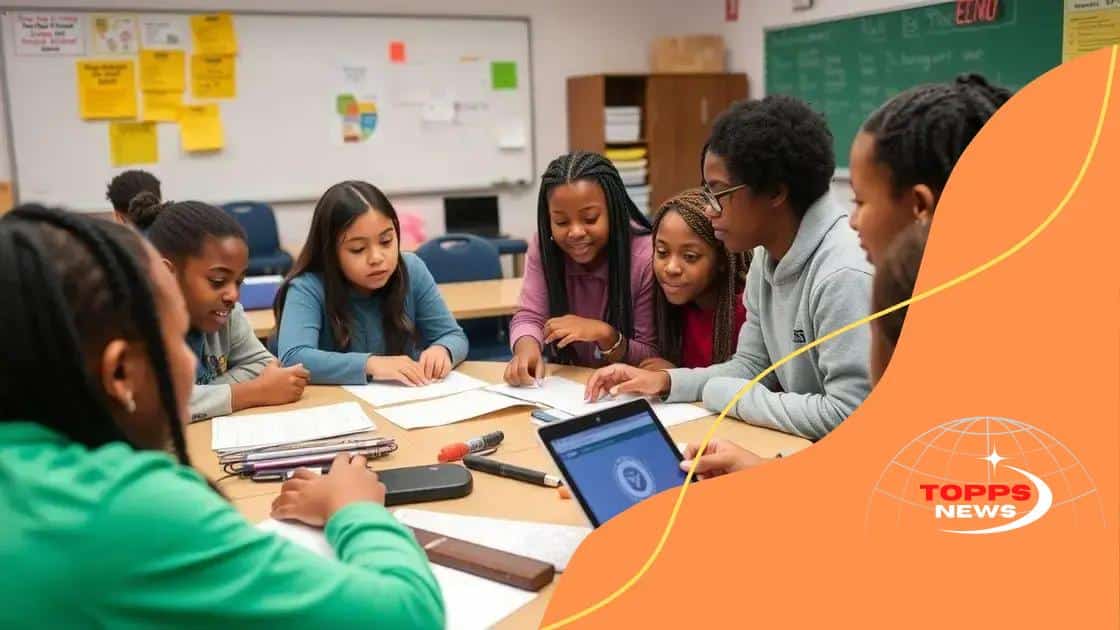Financial literacy curriculum integration: Transforming education

Financial literacy curriculum integration equips students with essential money management skills, enhancing their ability to make informed financial decisions and succeed in their financial futures.
Financial literacy curriculum integration is becoming increasingly vital in our education system. It equips students with the knowledge and skills needed to manage their finances wisely. But how can schools implement this effectively? Let’s explore.
Understanding financial literacy and its importance
Understanding financial literacy is crucial in today’s complex financial world. It involves knowing how to manage money, make informed financial decisions, and build a secure future. Without solid financial literacy skills, individuals may struggle with budgeting, saving, and investing.
The Importance of Financial Literacy
Financial literacy is not just about learning to use a calculator or complete tax forms. It’s much broader. It covers a range of skills and knowledge that empower individuals to take control of their financial lives.
Here are several reasons why financial literacy is important:
- Informed Decision Making: Financial literacy helps individuals understand their financial options. This allows them to make informed decisions about loans, investments, and savings.
- Financial Security: People who are financially literate are more likely to save for emergencies and plan for future expenses. This can lead to greater financial stability.
- Reducing Debt: A deep understanding of managing finances can help individuals avoid excessive debt and stay within their means.
- Long-term Goals: Financial literacy equips individuals with the tools needed to set and achieve long-term financial goals, whether that’s buying a home or saving for retirement.
By recognizing the significance of financial literacy, we can build a foundation for a society that values and practices sound money management. Schools, parents, and communities play vital roles in promoting these essential skills among young people.
Key components of an effective financial literacy curriculum
Key components of an effective financial literacy curriculum are essential for equipping students with the skills they need to manage money wisely. This curriculum should cover various topics that relate to everyday financial decisions.
Essential Topics to Include
An impactful curriculum should engage students with real-world scenarios that encourage them to think critically about their financial choices. Here are some key topics:
- Budgeting: Teaching students how to create and stick to a budget is fundamental. This involves tracking income and expenses to ensure they live within their means.
- Savings: Encouraging a savings mindset helps students understand the importance of setting aside money for future needs and emergencies.
- Investing: Introducing the basics of investing can help students appreciate how their money can work for them over time, including the benefits of compound interest.
- Credit and Debt: Understanding credit scores, loans, and how to manage debt wisely protects students from financial pitfalls in the future.
A successful program also incorporates interactive learning methods. For example, simulations and hands-on activities can make lessons more engaging and relatable. Group projects or discussions further enhance understanding by allowing students to share their insights and learn from one another.
Additionally, educators should consider the different learning styles of students. Incorporating visual aids, technology, and practical exercises can help cater to diverse needs. The goal is to create a curriculum that not only informs but also fosters enthusiasm for learning about personal finance.
Practical strategies for curriculum integration

Practical strategies for integrating a financial literacy curriculum into existing educational frameworks are essential for success. Teachers can find effective ways to weave financial concepts into various subjects and everyday classroom activities.
Integration Techniques
One effective method is to link financial literacy to subjects students are already studying. For example, in math classes, percentages and fractions can be taught using budgeting scenarios.
Here are some practical strategies for curriculum integration:
- Project-Based Learning: Implement projects where students create a budget for a class trip or plan a small business. This helps them apply financial concepts in real-life situations.
- Incorporate Technology: Utilize apps and games that teach financial literacy. Interactive tools can make learning more engaging and fun.
- Collaborative Learning: Encourage students to work in groups to solve financial problems or case studies. This promotes teamwork and critical thinking.
- Cross-Curricular Connections: Introduce topics such as economics in social studies or personal finance in health classes, discussing the financial aspects of healthcare.
Additionally, guest speakers from local banks, credit unions, or financial advisors can bring real-world experiences into the classroom. These speakers can share valuable insights and answer student questions, making financial concepts more relatable.
Lastly, assess students’ understanding through various methods like quizzes, presentations, or reflections on what they have learned. Assessment can guide future lessons and ensure students are grasping essential concepts.
Overcoming challenges in teaching financial literacy
Overcoming challenges in teaching financial literacy requires creativity and determination. Teachers often face obstacles, such as varying student backgrounds, limited resources, and time constraints.
Identifying Common Challenges
One major challenge is the diverse financial backgrounds of students. Some may come from families with strong financial knowledge, while others may lack basic money management skills. Understanding this diversity is crucial for tailoring lessons that resonate with all students.
Here are some common challenges educators might encounter:
- Lack of Resources: Many schools may not have the necessary materials or technology to effectively teach financial concepts.
- Time Constraints: With packed curricula, fitting financial literacy into classroom schedules can be difficult.
- Engagement Issues: Students may initially find financial topics boring or irrelevant, making it hard to capture their interest.
- Teacher Confidence: Some educators may feel unsure about their own financial literacy skills, which can affect their teaching.
To tackle these challenges, it’s crucial to implement engaging teaching methods. Using real-world scenarios can make lessons more relatable and interesting. For instance, discussing budgeting for a school event or planning a trip can draw students into the material. Additionally, integrating technology in lessons, such as using financial apps or simulators, can enhance student participation.
Collaboration among teachers is also beneficial. By sharing resources and strategies, educators can create a supportive environment that fosters learning. Professional development workshops focused specifically on financial literacy can boost teacher confidence and knowledge.
Measuring the impact of financial literacy education
Measuring the impact of financial literacy education is essential to understand how well students are grasping key concepts. This evaluation helps educators determine whether the curriculum is effective and where improvements may be needed.
Key Metrics for Evaluation
To assess the effectiveness of financial literacy programs, specific metrics should be used. These metrics can provide insights into the skills gained and behaviors changed among students.
Some important metrics to consider include:
- Pre- and Post-Assessment Scores: Conducting tests before and after the course can show how much knowledge students have gained.
- Behavioral Changes: Observing changes in students’ financial behaviors, such as increased saving or budgeting, can indicate greater understanding.
- Student Feedback: Gathering student opinions on the curriculum can help educators refine teaching methods to better meet their needs.
- Long-term Financial Habits: Tracking students after graduation can reveal whether financial literacy has lasting effects on their adult financial decisions.
Additional qualitative methods can be useful as well. Interviews and focus groups with students can provide deeper insights into their learning experiences. These discussions can highlight what aspects of the curriculum resonated with them and what could be improved.
Furthermore, engaging parents or guardians in the evaluation process can offer valuable perspectives. Their observations about changes in their children’s financial attitudes at home can enrich the understanding of the program’s impact.
In conclusion, integrating financial literacy into education is crucial for preparing students for the future. By measuring the impact of such programs, educators can ensure they are effectively equipping students with essential money management skills. Overcoming the challenges in teaching financial literacy allows every student to gain valuable insights, helping them to become financially responsible adults. With a supportive and engaging curriculum, we can foster a generation that excels in budgeting, saving, and making informed financial decisions.
FAQ – Frequently Asked Questions about Financial Literacy Education
Why is financial literacy education important?
Financial literacy education helps students learn essential money management skills, preparing them for responsible financial decision-making in adulthood.
What are effective ways to integrate financial literacy into the curriculum?
Effective integration can include project-based learning, using real-life scenarios, and engaging technology to stimulate interest and understanding.
How can teachers measure the impact of financial literacy programs?
Teachers can measure impact through pre- and post-assessments, behavioral observations, and student feedback to evaluate improvement in financial knowledge and skills.
What challenges do educators face when teaching financial literacy?
Challenges include diverse student backgrounds, limited resources, and ensuring engagement. Overcoming these obstacles is key to successful financial literacy education.





